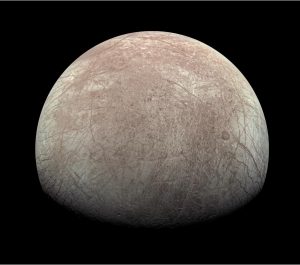
Global Space News: One year of #WebbWOW
It is said that you cannot recapture the childhood magic of Christmas. But any astronomer watching the skies on December 25 in 2021 will beg to differ. Because the most powerful space telescope ever constructed was about to launch.
The James Webb Space Telescope (JWST) is an infrared observatory with a sensitivity 100 times that of the Hubble Space Telescope. An international endeavour between NASA, ESA and the Canadian Space Agency, Webb has a design so complex that the telescope took several weeks after launch to fully deploy in a process involving hundreds of individual steps. This was a leap in engineering, notes Associate Professor Enya Keigo in the Department of Solar System Sciences.
JWST adopts a complicated structure, which was launched in a folded state and deployed in orbit, in order to achieve a large size. Even the primary mirror is composed of many segmented mirrors. This complex structure has succeeded not only in deployment, but also in optical precision adjustment! The deployment structure is technically advanced, but it is technology that breaks through the size limitation of rocket fairings. The success of JWST is therefore quite important from the viewpoint of the structure of future space telescopes.
Enya Keigo, Project Manager for JUICE/GALA-Japan (September 2022)
Once in space, the observatory had to complete the million mile journey past the Moon to the gravitationally stable L2 region, and cool to a temperature less than seven degrees above absolute zero (-266°C).
It took until summer this year before Webb was ready. Then the telescope turned its gaze on the heat signatures of the Universe.
As the first images were released, we responded with our initial impressions on the ISAS twitter. Grab a slice of Christmas cake, and let’s look at a few of the #WebbWOW highlights!
The oldest light
On July 11, US President Joe Biden released the first full colour image from the Webb telescope. Webb had captured a sea of galaxies whose light arced around the image centre. This was Webb’s first “deep field” that was produced by the observatory staring far into space for about 12.5 hours to capture immensely faint objects. Webb is focussed on a cluster of galaxies in the middle of the frame known as SMACS 0723. The gravity from SMACS 0723 is so strong that the light from more distant galaxies is bent to create arcs around this gravitational lens.

A staggering fact is that SMACS 0723 is so far away that the light now detected by humankind’s most powerful telescope was emitted before our own planet even formed. Much can be learned about the formation of galaxies from the details of this ancient light, explains Professor Yamada Toru in the Department of Space Astronomy and Astrophysics.
The image captures the cluster at a redshift of 0.39 (so we see their light emitted 4.6 billion years ago, when our Solar System was born in a corner of the disc of our Galaxy). We have never seen such sharp and deep images at near-infrared wavelengths. The image is full of the arcs and arc-lets due to the gravitational lens. Very accurate models of the mass distribution of the cluster, dominated by unseen dark matter, can be obtained. It is amazing to see the sharp resolved structures in the lensed images. With the help of the mass distribution models, and a technique for reconstruction, the un-lensed images of the distant galaxies will be obtained to study their very detail internal structure.
The image also contains a lot of interesting features of the cluster galaxies, for example, whose stars and gas are being stripped by the ram pressure of the cluster hot gas. The central giant galaxy shows a full of its globular clusters and dwarf galaxies at its outskirt.
Yamada Toru, Department of Space Astronomy & Astrophysics (July 2022)
Of dust and stars
One day later, four further images from Webb were released. These showed the star-forming Carina Nebula, the galaxy group known as Stephan’s Quintet, the atmospheric spectra of the planet WASP 96b, and the rings of dust and gas being expelled from a dying star that form the Southern Ring Nebula.

Webb’s primary mirror has an area seven times that of Hubble, but it is not just the light collecting power of the observatory that made these images spectacular. Webb is equipped with a Near-Infrared Camera (NIRCam) and Mid-Infrared Instrument (MIRI) which see the Universe in different wavelengths of infrared light. The NIRCam sees shorter wavelengths where stars are the brightest. MIRI captures the light from dust that surrounds young stars and is ejected in outflows and jets. The power of these two instruments combined was noted by Yamada when he first saw the image of the Carina Nebula.
The images of the Cosmic Cliff, which is a part of the Carina Nebula, is just amazing. Near-infrared (NIR) images obtained by the JWST NIRCam instrument show the distribution of the thick dust rich in shadows, just like a picture.
The composite image covers 1 – 20 microns and includes the image from the mid-infrared instrument MIRI which unveils stars being born that were not seen in the shorter near-infrared images due to absorption by dust.
Very interesting features, such as bi-polar flow of gas, or the gas blown outwards from the top of dust pillars seen around the protostars, are clearly captured. Previously Hubble could only see the short-wavelength NIR view, and Spitzer or Akari infrared telescopes had much more limited spatial resolution.
JWST has the aperture of 6.5m diameter and is capable of infrared observations, revealing this extremely ‘vivid’ picture of the star-forming regions.
Yamada Toru (July 2022)

The ability of MIRI to image dust was utilised in a proposal for one of Webb’s first science observations by Dr Ryan Lau while he was an ITYF research fellow at ISAS. Lau led observations to examine the dust production from a pair of stars that included a massive Wolf-Raynet star. The results revealed a series of concentric dust rings emanating from the stellar pair.
We’re looking at over a century of dust production from this system. The image also illustrates just how sensitive JWST is. Before, we were only able to see two dust rings, using ground-based telescopes. Now we see at least 17 of them.
Ryan Lau, NOIRLab (from a NASA JPL/JAXA press release in October)
The ingredients that drive the Universe
Webb also has the ability to break the infrared light into different wavelengths and compare the intensity. This reveals composition, as different molecules shine at specific wavelengths. A plot of the intensity of the light at different wavelengths is known as a “spectra”, and the instruments that measure it are “spectrometers”. Webb’s two spectrometers are the Near Infrared Spectrograph (NIRSpec) and the Near Infrared Imager and Slitless Spectrograph (NIRISS).

In the first set of images released by Webb, NIRSpec examined the composition of gas around an active black hole (AGN) in one of the galaxies in Stephen’s Quintet. This information is key for understanding how the galaxies affect one another, explains Yamada.
JWST obtained amazingly beautiful images of the group of galaxies known as Stephan’s Quintet. Four of the five galaxies are at a distance of 290 million light years and physically associated with each other (the last is a galaxy at 40 million light years which appears to be seen closely on the sky), and one galaxy has an active super massive black hole (SMBH) in the centre.
JWST vividly captures the distribution of the interstellar medium and star-forming regions in the galaxies.
The part of the image at wavelengths of 7-17 micron were taken by the instrument MIRI on JWST, and reveal the very interesting detailed structure in the distribution of gas and dust.
JWST’s NIRSpec instrument also obtained the detailed spectra of the selected regions so that astronomers can study how the close galaxy interaction can trigger star-formation and AGN activities in the closely interacting galaxies.
Yamada Toru (July 2022)

But spectra is not only good for unravelling interactions between galaxies. By looking at the wavelengths of starlight that passed through the atmosphere of an extrasolar planet orbiting a distant star, Webb was able to probe the planet’s atmospheric composition. These are observations that will take the exoplanet field into a new era, explains Associate Professor Elizabeth Tasker in the Department of Solar System Sciences.
In the last few decades, we have detected thousands of exoplanets. Now, we are building instruments capable of discovering what these worlds are like. If we look at the starlight after it passes through a planet’s atmosphere, we can see some wavelengths are missing because that light has been absorbed by the planet atmosphere. If we plot the intensity of this light at different wavelengths, we get the planet’s “spectra” (like we see for WASP-96b).
This is an incredibly challenging task, but the missing wavelengths can tell us what molecules must be in the planet’s atmosphere. This provides clues to the planet’s environment and how it formed. The spectra of WASP-96b is one of the clearest we have ever seen, and opens the door to a whole new era of knowledge on planets beyond our Solar System.
Elizabeth Tasker, Department of Solar System Sciences (July 2022)

The first exoplanet spectra released by Webb was for WASP-96b, and this was followed by observations of WASP-39b that included the first detection of carbon dioxide in the atmosphere of a extrasolar planet. Associate Professor Kawahara Hajime explains that when molecules such as carbon dioxide absorb particular wavelengths (or “colours”), the atmosphere becomes opaque at that wavelength and the planet appears slightly larger. This also allows for far more accurate measurements of the planet size.
JWST has released a new spectra of the atmosphere of an exoplanet that includes the signature of carbon dioxide. This is a measurement that takes advantage of the fact that the presence of molecules in the atmosphere causes a subtle size difference in the exoplanet depending on the observed colour. Looking at the JWST spectrum, we can see that the radius of the planet can be measured with an accuracy of less than 1%. It feels like the dawn of precision exoplanet science.
Kawahara Hajime, Department of Space Astronomy and Astrophysics (August 2022)
Both WASP-96b and WASP-39b are gas giant planets with orbits close to their star. Later observations by Webb revealed a detailed inventory of the atmospheric composition of WASP-39b that holds clues as to how giant planets were found on such tight orbits. Dr Hyodo Ryuki in the Department of Solar System Sciences notes the presence of water supports a key idea that such planets formed much further away from the star than their current orbit.
The colder it gets, the more materials freeze. To form giant planets such as Jupiter and Saturn, a lot of building materials are needed. Therefore, it is considered more convenient to form giant planets in cold regions far from the central star. However, many exoplanets are hot Jupiters that orbit very close to their central stars. One of the ideas behind the formation of hot Jupiters is that they form far away from the central star and then move closer to the central star.
The chemical composition of the atmosphere of the hot Jupiter, WASP-39b, has now been revealed by JWST! The results indicate that WASP-39b may have formed in a cold place where water freezes and then migrated to its present location. JWST will continue to observe the atmospheres of many exoplanets. It will allow us to see how special/common our Solar System’s Jupiter and Saturn are (together with the existence of a life-bearing Earth-like planet) will also become clear through comparison with exoplanets.
Hyodo Ryuki, ITYF Department of Solar System Sciences (December 2022)

This composition of planet atmospheres will be investigated still further by Ariel, a mission led by the European Space Agency with Japan involvement. Ariel will aim to examine enough planets to form a statistical survey, complementing Webb’s high sensitivity observations as Enya Keigo describes.
JWST has presented a wonderful observation of the atmosphere of an exoplanet, WASP-39b. Due of the importance of observing the atmospheres of exoplanets with space telescopes, we are participating in the ESA-led Ariel project (schedule for launch in 2029) both in terms of the development and science. The Ariel telescope is smaller than JWST, but unlike JWST, it is dedicated to observe transiting exoplanets.
Enya Keigo, Project Manager for JUICE / GALA-Japan (December 2022)
Ariel will study what exoplanets are made of, how they formed and how they evolve, by surveying a diverse sample of about 1000 exoplanets, simultaneously in visible and infrared wavelengths. With its larger mirror and various onboard instruments, JWST is able to observe a select number of smaller planets and those around less bright stars with higher sensitivity, and also to perform direct imaging of exoplanets. Therefore, the two telescopes will be strongly complementary one another for exoplanet
To see a new world
It is not only in planetary atmospheres that Webb is spearheading the exoplanet field. Both the NIRCam and MIRI are equipped with coronographs, which can mask the light of a bright star to see a nearby far fainter object. And in September, the two instruments released Webb’s first direct image of the extrasolar planet, HIP 65426 b. Enya says this is a second technique that may revolutionise our knowledge of extrasolar planets in the future.

NASA’s James Webb Space Telescope has succeeded in its first direct imaging of an exoplanet (this exoplanet is a gas giant, not a terrestrial planet). The James Webb Space Telescope will provide us with much new knowledge about exoplanets.
In general, spatially resolved direct imaging of an exoplanet is difficult because of the central star that is overwhelmingly brighter than an exoplanet. However, with the realisation of an advanced future space telescope equipped with an instrument that suppress vastly the light of the central star, direct observation will be a powerful method for studying the characteristics of terrestrial planets that could harbour life. The reported result is an important success, but also a starting point.
Enya Keigo (September 2022)
The up-coming NASA-led Nancy Grace Roman Space Telescope will further direct imaging with a more advanced coronograph when it launches later this decade.
Hello neighbour!
The Webb Space Telescope had proved its ability to study the celestial goings on far from the Earth, from the earliest galaxies to alien worlds around other stars. Yet, the observatory’s capabilities at the much closer quarters within our own Solar System proved to be just as spectacular.

In August, Webb released an image of Jupiter seen in the infrared, revealing incredible details of the planet’s colossal atmosphere, as Dr James O’Donoghue in the Department of Solar System Sciences describes.
In my research I look at the upper atmosphere of Jupiter, several thousand kilometres above the visible clouds you can see in images. With JWST we can see Jupiter’s infrared auroras in the extended upper atmosphere above the planet. The planet’s eastern limb has a slither of shadow running around it, and above that you can see an arc of glowing atmosphere. Its origin is under debate, but I’m quite convinced that it’s something called “airglow” and that it comes from the upper atmosphere. High definition images and video from the International Space Station record Earth’s airglow regularly, but it’s simply astonishing we can see it from Jupiter at this distance. That’s what makes this is one of my favourite images of Jupiter, ever!
James O’Donoghue, Department of Solar System Sciences (August 2022)

This was followed in September by an unusual look at Neptune, showing that the planet is actually surrounded by rings. Despite rarely appearing in images other than those of Saturn, Hyodo Ryuki explains that rings are actually common among the giant planets.
When we think of rings, we think Saturn! But Jupiter, Uranus and Neptune also have rings. This time, humankind’s newest “Eye”, JWST, has now captured the rings of Neptune. These look completely different from the rings that surround Saturn, and are characterised by a very thin ring. Planet rings are formed when the planet itself forms, so it is natural to consider ring systems as a byproduct of planet formation. Therefore, each planet having an individual ring system indicates that each planet grew and evolved in a different environment and conditions. This makes rings are a very interesting subject for studying the history of the planets in our Solar System.
Hyodo Ryuki (September 2022)
Tell the world
It has been an amazing year, watching the James Webb Space Telescope successfully unfurl from launch and capture an entirely new view of our Universe. Great efforts were made to share the journey of the new observatory, allowing us all the chance to join the expedition to change our understanding of the cosmos.
It’s great that JWST shared their early images and spectra so soon after they were acquired. The JWST team had also showed us how the telescope unfolded into place and calibrated itself. The team’s transparency was excellent for science communication as it revealed the engineering complexity and risks, which allowed the public to experience the tension and drama of the mission, making them feel a part of it. Ultimately, this helped everyone appreciate and share in the triumph of the images and results we saw last week.
James O’Donoghue (July 2022)
“Global space news” is a chance for us to highlight important developments across the world and share our excitement of these achievements.
Further Information:
James Webb Space Telescope website (external site)
The Webb Telescope sees a star duo shed rings of dust into the Universe (press release)
Ariel Space Telescope website (external site)







 Previous Post
Previous Post Next Post
Next Post






